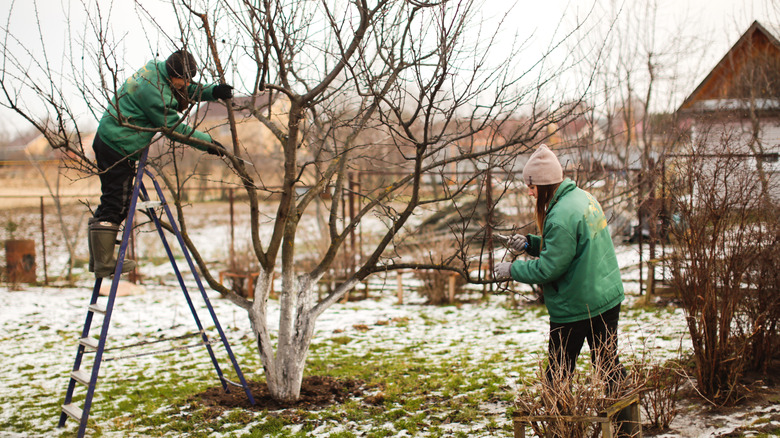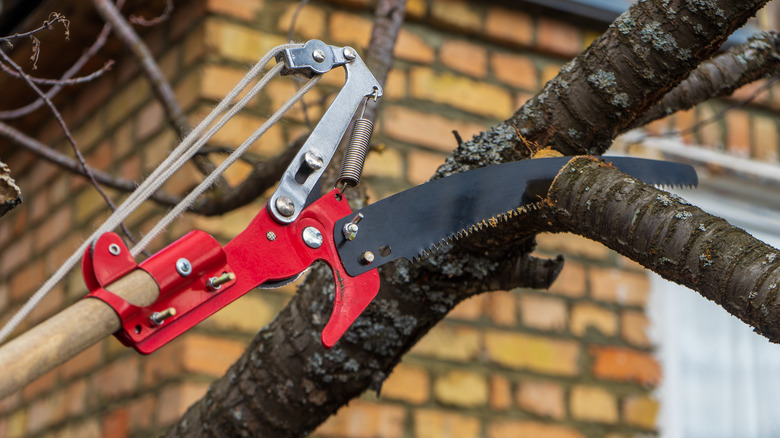When you hear that a snowstorm is coming, you might have a list of things you want to tackle before it starts coming down. You might want to finally caulk that one drafty window, make sure you have enough salt stocked up for your driveway and stairs, or get a can of gas for your snow blower. Doing these things ensures you’re as prepared as possible to weather the storm both during and after. However, there is probably one thing you’re overlooking to do, and it has to do with your yard and safety: pruning dead or broken tree limbs. Not doing so can lead them to snap under the weight of snow or harsh winds, which can damage anything from your house to your car, and can hurt anyone standing nearby.
No one wants to walk out into their front yard and see that a broken tree branch has fallen on their car or broken the window of their garage. To avoid that, prior to the severe weather, walk your property and see which branches should be trimmed. While pruning trees might seem like a spring activity, winter is actually one of the best times to do so. So take this as a chance to cross off a lingering task from your to-do list. Here is why this should be at the top of your storm-preparation list.
Why you should prune dead or broken branches before a snow storm

Severe weather can damage trees in all sorts of ways. Heavy snowfall can accumulate on their branches, and weak ones can snap under their weight. Heavy winds can easily snap old limbs off a tree, and thick icicle formations can break them due to their heaviness. This can lead to all sorts of property damage or, even worse, bodily harm. But which limbs should you prune back? The North Carolina Forest Service advises you to look for diseased, decaying, or damaged branches. You will know if the branch is sickly if it has pieces of bark missing that it can’t seem to regrow, is dry and brittle, or easily snaps under pressure. If you’re unsure, you can scratch the branch in question and see how it looks under the bark. If it’s green, it’s alive, and if it’s brown and dry, it’s diseased or dead.
It is also recommended to remove any rubbing branches prior to the storm, even if they’re healthy. While these might not snap, crisscrossing branches in severe weather can constantly bump and rub against each other, creating wounds in the bark. These wounds can expose the tree to pests and disease, which will lead to problems come springtime. If you’re a newbie to tree care and aren’t sure which branches need trimming, hire an International Society of Arboriculture (ISA) certified arborist to do so. You can find one via the Find an Arborist search tool.
How to prune trees before a storm

Luckily, pruning a tree during wintertime is preferred and encouraged over other seasons. Not only is it easier to see which branches need to be cut since there are no leaves present, but due to the cold weather, you’re also less likely to attract pests to the wounds or cause disease. Lastly, during winter, the tree is also in a state of hibernation, which ensures it won’t waste energy on releasing new growth. One of the biggest downsides of pruning during the late summer or fall is that pruning will lead to new leaf or node growth, which will be too underdeveloped to survive the approaching winter. That means the tree wasted energy on creating that greenery rather than saving it for the upcoming dormant period. The death of the new growth can also potentially damage the tree or lead to disease. Pruning it during the winter nixes that issue. However, there is one caveat: You can only prune evergreens during growing seasons, or else they can suffer damage. That’s because these trees never really go into a hibernation period.
To prune the tree properly, there are a few rules you need to follow. First, you can’t remove more than 20% of the tree’s crown at a given time. That means if you have several diseased or damaged limbs, you need to decide which are most at risk for causing damage and leave the rest for next year. You also want to cut the branch as close to the trunk or collar as possible. Avoid cutting it mid-branch, as this can cause stress to the tree.



